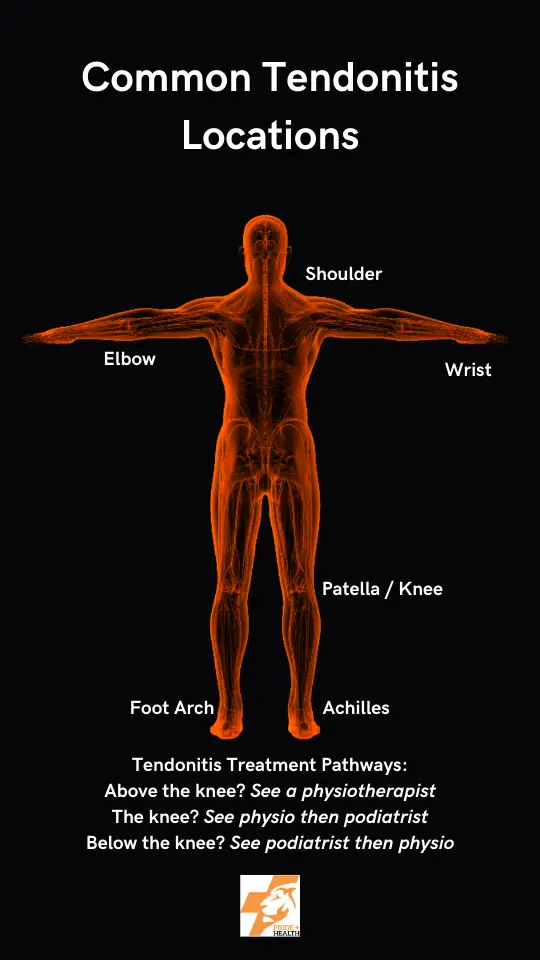Tendonitis: How to Treat and Heal Tendons
Our team or podiatrists and physiotherapists have seen our fair share of tendonitis cases over the years. In this post we’ll take you through tendonitis in detail.
If you’re suffering with tendonitis or tendon pain you can book in with our team here
What Actually Is Tendonitis?
Tendonitis is a condition in which the sheath around a tendon is injured and inflamed. In fact, the suffix -itis means inflammation and in the past any sore tendon was described as having tendonitis.
These days we know much more than we used to about tendons and we’ve learned that most tendons do not become inflamed themselves when overloaded and sore. This is due to tendons being avascular (in their non-injured state). Avascular means no direct blood supply, which leads to no pathway for an inflammatory response to occur.
As such, most conditions that used to be called tendonitis, are now called tendinopathy. This term better describes an over worked and sore tendon which usually does not have any inflammation.
We now use tendonitis much more to describe the inflamed sheath around the tendon, known as a paratenon.
Is Tendonitis Very Painful?
Pain is really personal, what my pain and your pain feels like to us will vary. That being said, there are some consistent patterns when it comes to how painful tendonitis is.
Acute tendonitis, that is a tendonitis that’s new and “fresh” will usually feel like a sharper pain. It might stop you from moving the joint the tendon attaches to. The pain can settle with a bit of movement but will often return after repeated moving.
An example of this is for achilles tendonitis. The first few steps when you get going can feel sharp however it can warm up and feel pretty good for a while. As you keep moving around on your feet the pain then gets worse again the more steps you take.
Chronic tendonitis is where the tendon has been overloaded for a longer period of time. You’ll often feel a dull but constant soreness. It can feel worse when you first start to move and like acute tendonitis it then eases up as muscles get warmer.
Some people will rate their tendonitis as severe pain. A 10 out of 10 on the pain scale whereas others barely note a 1 or 2 out of 10. This can be due to a variety of factors and coping mechanisms we have in place. Any pain from tendonitis is our body telling us that we need to do something different. So paying attention, listening to our body and then making changes is crucial.
Most Common Tendonitis Locations

- Tendonitis in the foot
- The achilles is the largest tendon in the body and can become sore at the tendon insertion or tendon midportion
- Tendonitis in the ankle
- The posterior tibial tendon which wraps around the inside of the ankle into the foot can develop into a severe adult acquired flat foot deformity
- Tendonitis in the wrist
- Mummy wrist also known as De Quervain’s tendonitis is a repetitive stress injury of the wrist too many Mum’s get to know about
- Tendonitis in the knee
- The patellar tendon is often overloaded with athletic activities and has been called “jumper’s knee”
- Tendonitis in the shoulder
- A frozen shoulder or rotator cuff tendonitis can severely limit our ability to complete everyday activities such as hanging the washing on the line
- Tendonitis in the elbow
- Tennis elbow is one of the forms of tendonitis we’ve heard our sports heroes, friends and family suffer from
What Causes Tendonitis?
Tendonitis is your body’s way of telling you that you’re putting too much stress on the tendon.
As we discuss in our tendon post, there’s two main types of load or stress on a tendon. Compression and tensile loads. Our tendons love tensile loading and can handle large demands if applied in this manner. They don’t like compressive loading as much and it does not take as much compression before they start to become pathologic.
Distilling the causes of tendonitis down even simpler, you get tendonitis when you ask the tendon to do too much. The demand out strips capacity.
Things that increase the demands on our tendons are volume, the more we use them. The loads, the heavier we are or how much we lift. The rate at which we apply force. Tendons find fast loading (think springing type movements) more difficult than slow loading.
Imaging tests are sometimes used if during the physical examination your physio or podiatrist needs some more information about your tendon. Imaging can help differentiate between tendonitis and tendinopathy. To show if there’s an inflamed tendon sheath or something a little different. The less common issues are calcium deposits within a tendon or gout. These can be picked up with ultrasound imaging and blood tests.
Diseases That Cause Tendon Pain
Tendonitis is more likely to occur if we have diseases such as diabetes, rheumatoid arthritis (reactive arthritis and psoriatic arthritis) or metabolic syndrome. Some medications we take for good reasons for common conditions also have the side effect of increasing the risk of tendon pain.
Your personal risk factors for your tendonitis will be determined in your physical exam with your physical therapist (physio or podiatrist).
What Is The Best Treatment For Tendonitis
The best treatment for tendonitis of any tendon (foot, leg, shoulder, arm, wherever) is an appropriate loading program. An appropriate loading program is an exercise regimen where you’re going to be working on increasing the capacity of the tendon to handle load.
This will have effects in multiple areas, in particular your connective tissues:
- Tendons will become larger, stronger and more elastic if loaded appropriately.
- Muscles will become larger, stronger and better at pulling on tendons as they are loaded appropriately.
- Our neuromuscular control will increase and ensure our tendons are appropriately taut when they need to be and relaxed at other times.
If you follow a proper treatment program which has been personalised to your needs you can expect to maintain many of your physical activities.
While treating tendonitis with a loading program there are other things that you can do to improve your results. For pain, short term courses of anti-inflammatory medications might be appropriate. Using non-steroidal anti-inflammatory drugs can help lessen the pain of tendinitis but they should not replace your loading or rehabilitation program.
Lower limb tendon problems can also be treated with footwear and orthotics. For example using heel lifts with achilles tendonitis can reduce the demands on the achilles every time you take a step. Orthotics too can push on the foot to decrease the both the compression and tensile stress on the tendons in the foot, ankle and lower limb.
Extra corporeal shock wave therapy is a new treatment which has been shown to aid healing in tendonitis. It’s important to note, the use of shockwave therapy for tendonitis is still in its infancy and the positive results are still coming through to influence practice.
Will Tendonitis Heal On Its Own?
No, tendonitis will not heal on it’s own. If you have a painful tendon and it hurts when you run, and then you cease running, the flare up in symptoms would likely settle. The issue here is that your tendon capacity was lower than what it needed to be to handle those activity levels, and we all need to be able to move as effectively as possible. While you might be comfortable with a decision to stop running now, what happens when your tendon flares up from just walking? Is stopping walking a reasonable response for you?
Thought so.
Waiting for tendonitis to heal on it’s own is not a good idea. Think of tendonitis of your body’s way of letting you know it needs some TLC. It’s the trigger to start an appropriate loading and exercise program.
If tendonitis is not treated then there is a risk of tendon rupture. This can be a very painful injury in which the muscle to bone connection is completely torn. Luckily there’s good evidence that physical therapy can repair ruptured tendons although you will be working for a long time with your physiotherapist.
How Long Does Tendonitis Take To Heal?
The healing time of tendonitis varies greatly from person to person. Tendon’s in the upper body tend to heal faster than the lower body. As we age and get older our soft tissues like tendons and muscles take longer to heal as well.
Finding time to complete the appropriate loading and exercise programs as well as recovery sessions will allow your tendon to heal in the fastest possible time for you.
The expectations are that for lower limb tendonitis you’ll be completely your loading program for as least 3 – 6 months. In this time your symptoms would be improving as you go and you’ll be more and more active.
For upper limb tendons the healing time can start at around 1 month and extend from there.
How Can I Make Tendon’s Heal Faster?
The only ways to make your tendonitis heal faster are to maximise everything:
- Maximise your training to be 100% appropriate for your tendons needs.
- Ensure you’re getting appropriate nutrition, getting plenty of sleep and relative rest from your training loads.
- Shockwave looks like it could be a way to improve your tendon healing although this is still very much in it’s infancy.
- For lower limb tendonitis your pain levels and function can often be improved with the right shoes and orthotics.
There may be a place for corticosteroid injections in some cases. Where a steroid injection can excel is pain relief. Where they post large risks is that they weaken the tendon and bone. If considering a corticosteroid injection as one of your treatment options ensure you have a thorough understanding of the risks you’ll be entertaining with your treating physiotherapist.
How Long Does It Take For Tendonitis To Go Away?
Tendonitis pain can go away very quickly, within days to weeks of starting a program. The challenge is that it will come back as your activities change from normal day to day life.
As we discussed above, to heal a tendon to the point where you’re able to be your most active self can take from 1 to 6+ months. This is assuming you’re able to maximise your treatment and recovery plan with your physiotherapist or podiatrist.
Your treating physio or podiatrist would most likely be able to get you back to many of your daily activities very quickly. The more taxing repetitive activities could take a little longer but they’ll be even more enjoyable when you return to them.
Would you like to know more?
Our team love helping sore tendon’s get back to their best.




